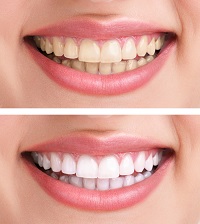
Whitening
Many patients today want whiter teeth. Patients should consult with a dentist to determine the reason for the tooth discolouration and to see if bleaching will achieve the desired results. This is especially important for patients with fillings, root canal treatments, crowns and/or with extremely dark stains on the anterior teeth.
Only natural tooth enamel will bleach. Fillings and crowns will not bleach, but can be replaced to achieve a lighter shade. Also, if any cavities are present in the area to be bleached, they should be filled first prior to bleaching. This would avoid potentially damaging or irritating the nerve of the tooth with the bleach due to the hole(s) in the tooth from the untreated cavity. In most cases, bleached teeth will periodically need to be bleached again to maintain the lighter shade.
Most commonly, the custom made tray (similar to a mouthguard) is made in which the bleach is placed and worn for a few hours each day for a week or two. During the bleaching process, teeth may become sensitive and there may be some irritation to the soft tissue. These effects typically resolve after patients are finished with the bleach. It is helpful to use a toothpaste for sensitive teeth during the bleaching process.
Teeth that have discolored after root canal treatment may require some internal bleaching (from the inside as a separate procedure) as opposed to external bleaching with a tray as described above. Or, a crown may be recommended with the desired shade to correct the discoloration problem and help prevent the tooth from fracture.
For further detail, please visit:
Our team
Dentists :
Dr Michelle Power
Dr Erin McGuire
Address
53E Clark Rd, Rothesay
NB, Canada, E2E 2K9
Tel: (506) 847-9836
Fax: (506) 847-9256
Email: [email protected]
BUSINESS HOURS
Monday 8:30am-4:00pm Tuesday 10:15am-6:00pm Wednesday 8:30am-4:00pm Thursday 8:30am-4:00pm Friday 8:30am-4:00pm Note:The clinic is open occasional Fridays and it varies from week to week Cash, Visa, Mastercard, and Debit accepted.
Emergency dental services available on weekends. For details call the our office.
Address
KV Dental
53E Clark Rd,
Rothesay, NB
Canada, E2E 2K9
Tel: (506) 847-9836
Fax: (506) 847-9256
Email: [email protected]
Web: www.kvdental.ca


